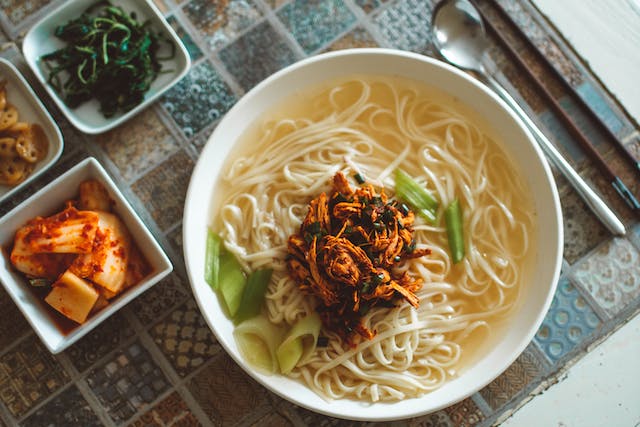6 Korean Food Habits and Rules to Remember
Korean cuisine is not just about the tantalizing flavors that dance on your taste buds; it’s a cultural experience that extends to the dining table.
For today’s blog, we have asked our dear Korean teacher Yaeyoung to help us understand the intricate tapestry of Korean food habits, where tradition and respect play a crucial role in the enjoyment of a meal.
1. The Oldest Eats First
In Korean culture, respect for elders goes beyond mere words—it’s a practice observed even at the dinner table. The unwritten rule dictates that the eldest person begins the feast, setting the tone for the family meal. Whether you find yourself in the esteemed position of the elder or a respectful participant, understanding this custom adds a layer of cultural richness to your dining experience.
For children, this extends to not lifting utensils before an adult and using both hands when pouring a drink—an embodiment of respect deeply ingrained in Korean etiquette.
→Sign Up Now: Free Trial Korean Lesson With a Native Speaker Teacher!←
2. Soup and Rice Placement Etiquette:
When indulging in a traditional Korean meal, the arrangement of dishes matters. Soup finds its place to the right of the rice, accompanied by the spoon, and it is a breach of etiquette to eat with a bowl in hand. To eat this type of food, use a spoon for rice and soup, and remember: leaving the utensil stuck in the bowl is a culinary faux pas.
Oh, and in case you’re wondering what kind of soup Koreans prefer, Yaeyoung has the answer: “One of the most popular Korean soups is “Samgyetang,” featuring a whole chicken stuffed with glutinous rice, ginseng, garlic, and jujube, boiled into a hearty and nutritious broth. Another favorite is “Doenjang Jjigae,” a soybean paste stew, typically containing tofu, vegetables, and sometimes meat, creating a savory and comforting dish.”

3. Sharing is Caring
In Western cultures, individual portions are the norm, but in Korea, sharing communal dishes is the standard practice.
Let us give you a few examples. The banchan, an assortment of small side dishes, is a quintessential element of communal eating. These diverse and flavorful side dishes, ranging from kimchi and pickled vegetables to savory pancakes and marinated tofu, stay at the center of the table for everyone to share. This allows diners to explore an array of tastes and textures, turning the meal into a sensory adventure.
Moreover, the sharing ethos extends to main dishes like bulgogi and galbi, where thinly sliced marinated beef or succulent grilled ribs are often prepared at the table and shared among diners.
As you can see, Korean meals are meant to be shared amongst family and friends, so don’t be shy to dig into that dish your neighbor is savoring.
4. The Importance of Saying “Jal-mukkes-seub-nida”
Before taking your first delectable bite, a simple yet meaningful phrase adds a touch of politeness to your dining experience.
Uttering “Jal-mukkes-seub-nida,” (translating to “I will eat well” or “I will enjoy this meal) is not only a customary way to acknowledge the delightful food in front of you but also a way to pay respect to the person behind the culinary magic.
5. Finish with Grace
As the meal concludes, expressing gratitude to your hosts takes center stage in the dining ritual. As our Korean teacher Yaeyoung says, “A heartfelt “jal-meokeos-seum-nida”, meaning ‘I ate well,’ transcends mere courtesy—it’s a sincere acknowledgment of the shared culinary journey. It’s like offering a piece of your appreciation back to the table.”
In the nuanced world of Korean dining culture, finishing with grace becomes a brushstroke that not only concludes the meal but also deepens the connection forged over shared dishes.
6. No Nose-Blowing at the Table
Blowing your nose at the dinner table in Korea is impolite. Yaeyoung emphasizes this cultural nuance: “In Korea, we lean towards sniffling discreetly rather than blowing your nose outright. It’s a subtle but significant aspect of dining etiquette, ensuring the atmosphere remains harmonious and respectful.”
Understanding and adhering to this cultural nuance, as Yaeyoung points out, becomes a conscious effort to maintain a considerate and pleasant dining environment.

7. Not too Spicy, Please:
Contrary to popular belief, not all Korean food sets your taste buds on fire. Only a modest 20-30% leans towards spiciness, showcasing the diverse palette of Korean cuisine. While the allure of fiery dishes captivates the younger generation, it’s essential to recognize the nuanced flavors that span the spectrum of salty, sweet, sour, bitter, and umami.
Korean food says Yaeyoung, is a symphony of complex tastes that invites you to savor the richness beyond the heat. So go ahead, give your taste buds a break from the spice and explore the diverse flavors of Korean cuisine.
Learn Korean with Language Trainers
The Korean food habits we’ve explored in this article are just the tip of the iceberg when it comes to understanding this unique and vibrant culture. From respect for elders and communal dining to expressing gratitude and appreciating diverse flavors, Korean cuisine offers a glimpse into the deep-rooted customs and values of its people. So next time you sit down for a traditional Korean meal, remember to cherish not just the food but also the cultural experience it offers.
→Sign Up Now: Free Trial Korean Lesson With a Native Speaker Teacher!←
Would you like to embark on a culinary journey that transcends flavors and dives deep into the heart of Korean culture? Then why not take the next step and explore the language with Language Trainers?
For more than 20 years, we have been connecting language learners and native-speaking teachers for personalized lessons that cater to their individual learning styles. Whether you want to take an in-person Korean course in New York or take an online Korean course from your home, we’ve got you covered. So why wait? Dive into a learning journey with us and discover the beauty of this fascinating country and its culture like never before.
